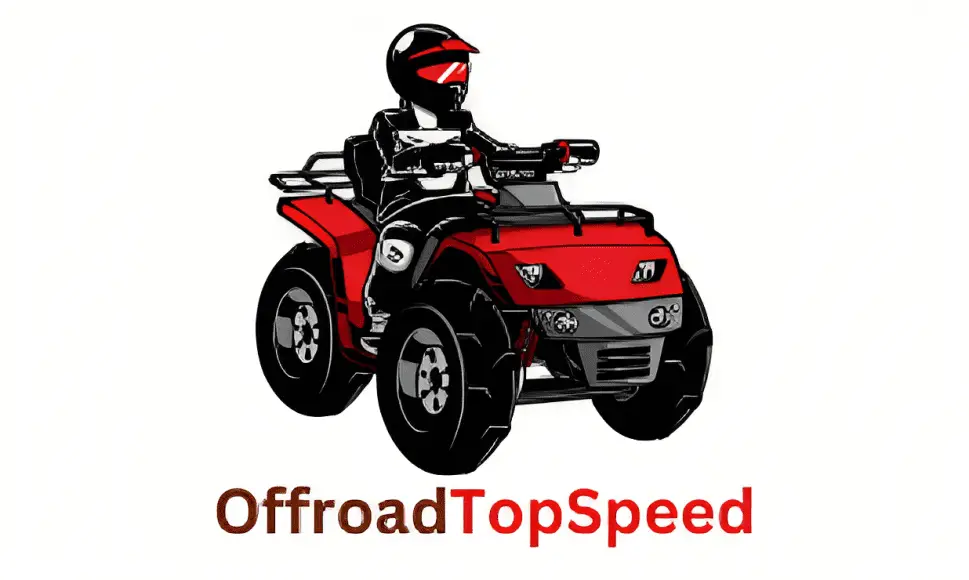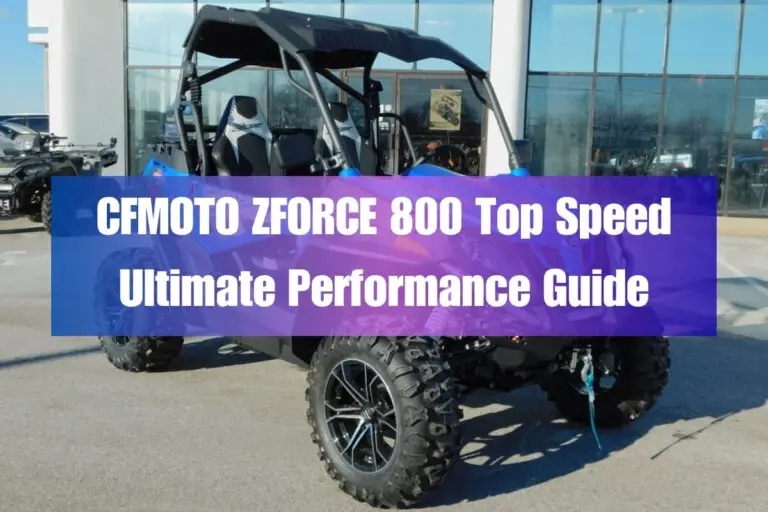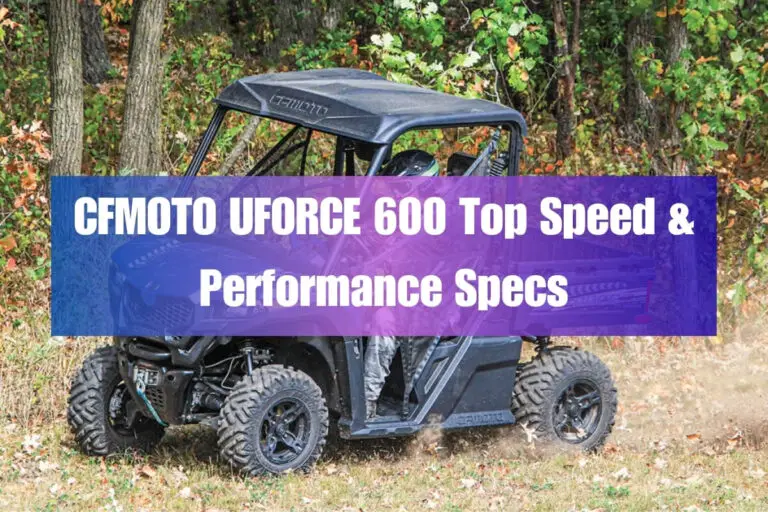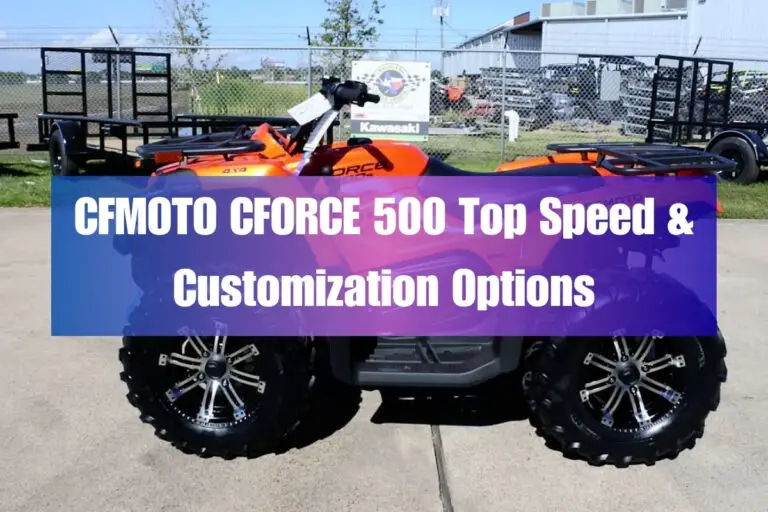2023 CFMoto 300SS – Specs, Performance and Rival Comparison
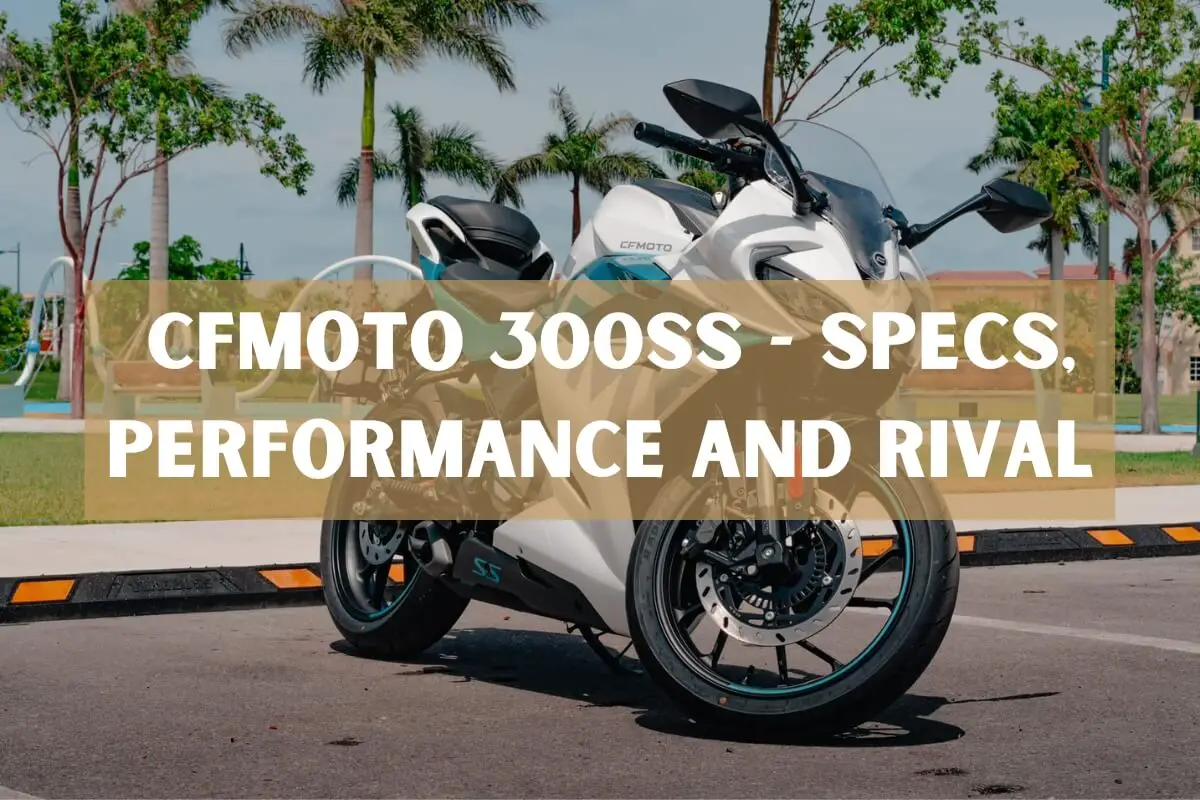
With a 292cc liquid-cooled, DOHC single-cylinder engine producing 29 hp and 18.7 ft-lb of torque, nimble handling, and surprisingly polished fit and finish for its class, the 2023 CFMoto 300SS makes a compelling case in the lightweight sportbike segment. Boasting a top speed of 87 mph, this Chinese contender weighs just 364 pounds wet and promises quick acceleration and effortless maneuverability against rival 300-400cc machines from Yamaha, KTM, Kawasaki and others.
But can this newcomer truly hold its own on the track and streets against more established names? With inverted front suspension, radially mounted brake calipers, a slipper clutch, and premium details like LED lighting, the 300SS checks most of the right boxes on paper. As we put this bike through its paces, we’ll outline key specs like its 78mm bore & stroke, 37mm front forks, and 140-section rear tire, assess real-world performance including acceleration, handling and braking, and relay owner impressions from test rides.
Read on to see if this sharp-looking, nimble CFMoto can run with the Japanese and European competition for lightweight sportbike supremacy.
Overview and Key Specifications
Behold the 300SS – CFMoto’s first proper foray into the small-displacement sportbike segment. New to CFMoto? This Chinese manufacturer has been rapidly expanding its motorcycle lineup beyond its ATV and adventure bike roots, gaining respect for producing affordable, quality machines.
The 300SS is equipped with a 292cc liquid-cooled single-cylinder DOHC 4-valve engine, with Bosch EFI, 4-valve cylinder head and a 11.5:1 compression ratio. This free-revving powerplant produces 21.4kW (29hp) at 8750RPM, with max torque of 25.3 Nm (18.7 ft-lb) arriving at 7250RPM.
Power gets transferred to the rear 3.5 x 17-inch aluminum alloy wheel via a 6-speed transmission with a CF-SC assist & slipper clutch. The 300SS features a steel trellis frame, with sporty geometry figures of 24 degrees rake and 95mm trail. Suspension consists of upside-down telescopic forks with 37mm stanchions, along with a preload-adjustable rear mono suspension.
Some key specs and features:
| Specification | Detail |
|---|---|
| Engine Type | Single-cylinder, liquid-cooled, DOHC, 4 valves |
| Displacement | 292 cc |
| Bore x Stroke | 78mm × 61.2mm (3″ x 2.4″) |
| Power | 21.4 kW / 29 hp @ 8,750 rpm |
| Torque | 25.3 N-m / 18.7 ft-lb @ 7,250 rpm |
| Fuel Supply | Bosch® EFI |
| Transmission | 6-speed, wet, multi-plate, CF-SC slipper clutch |
| Length x Width x Height | 2,010 × 750 × 1,080 mm; 79 x 29.5 x 42.5 in |
| Wheelbase | 1,360 mm; 53.5 in |
| Seat Height | 780 mm; 30.7 in |
| Curb Weight | 165 kg; 364 lbs |
| Fuel Capacity | 12 L; 3.2 gal |
| Front Suspension | Upside down telescopic fork, hydraulic damping |
| Rear Suspension | Mono suspension, center aligned |
| Front Brake | 292 mm single disc, 4-piston caliper |
| Rear Brake | 220 mm single disc, single-piston floating caliper |
| Rims | 3 x 17/3.5 x 17 MT Aluminum alloy |
| Tire | Front: 110/70 R17 <br> Rear: 140/60 R17 |
| ABS | Continental ABS, dual-channel |
| Model Colors | Ghost Grey, Nebula Black |
| Additional Features | LED headlights, taillights, and signal lights; 5″ TFT display with Bluetooth and CFMOTO Ride App connectivity |
What Kind of Power and Acceleration Does the 2023 300SS Deliver?
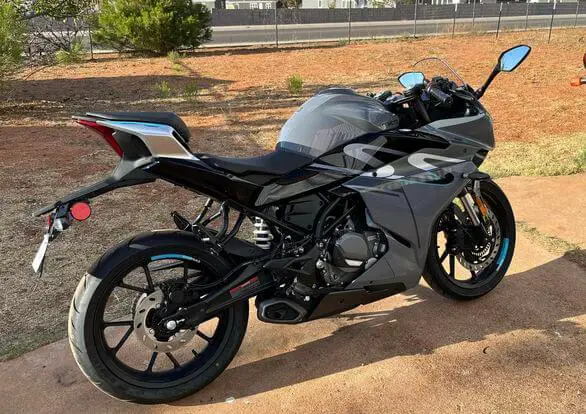
The free-revving 292cc liquid-cooled single-cylinder engine powering the 300SS puts out 29 horsepower at 8750 RPM, along with 18.7 ft-lb of peak torque arriving at 7250 RPM – decent numbers for this class.
Engine power builds smoothly in the mid-range, feeling sporty even at city speeds while pulling nicely towards the 8750 RPM redline. Don’t expect neck-snapping acceleration – sub-300cc sportbikes focus more on nimble handling versus straight line speed. Still, there’s enjoyable thrust that provides a fun, engaging riding experience whether carving canyon roads or daily urban commuting.
While specific acceleration test figures are unavailable currently, we can estimate the 300SS with its 364 lb wet weight to hit 60 mph in around 5.5 seconds based on its power-to-weight ratio, putting it mid-pack in the class. Performance should be comparable to the likes of the Yamaha R3 and KTM RC 390.
Not blisteringly quick, but adequate pep to thrill novice riders while keeping more experienced pilots entertained. Combined with its lightweight feel and sportbike ergonomics, the 300SS promises hours of grin-inducing riding.
What Is the Top Speed of the 2023 CFMoto 300SS?
We don’t have an officially confirmed top speed figure for the 2023 300SS currently. However, based on the bike’s 29 hp power output and gearing, we expect it to comfortably eclipse 87 mph given enough road.
Comparison with Rivals
The 300SS does not produce peak horsepower on par with rivals like the Yamaha YZF-R3. The R3 has a claimed output of 42 hp at 10,750 rpm, which is much higher than the 300SS’s 29 hp at 8,750 rpm. The 300SS also does not have similar wet weight and aerodynamics as the R3. The R3 weighs 375 lb wet, which is 11 lb more than the 300SS. The R3 also has a more aggressive riding position and a lower windscreen, which may affect its drag coefficient.
Therefore, we anticipate a top speed in the range of 87-90 mph for the 300SS – quick enough for legal highway cruising and track days, while keeping things sensible for a lightweight beginner sportbike. Its top speed should ultimately land between the lower tuned Kawasaki Ninja 400 (around 116 mph) and the high strung Yamaha R3 (capable of hitting 112+ mph in stock form).
Acceleration and Stability
While acceleration lacks sharpness, the 300SS maintains speed nicely once the revs and gears build. The bike feels stable and secure approaching triple digits, helped by upside down telescopic forks with 37mm stanchions and mono suspension with center alignment and preload adjustment and grippy 110-series front and 140-series rear radial tires, giving confidence to maintain high velocities. It may take some time getting there, but holds velocity nicely once into higher speed ranges.
Conclusion
Considering its entry-level friendly price and orientation, a top speed circa 87 mph feels appropriate for the intended audience while offering sufficient thrust for highway merging and passing. Quick riders may crave more steam, but as an all-round package the 300SS strikes a nice balance.
What Factors Determine the 300SS’s Top Speed?
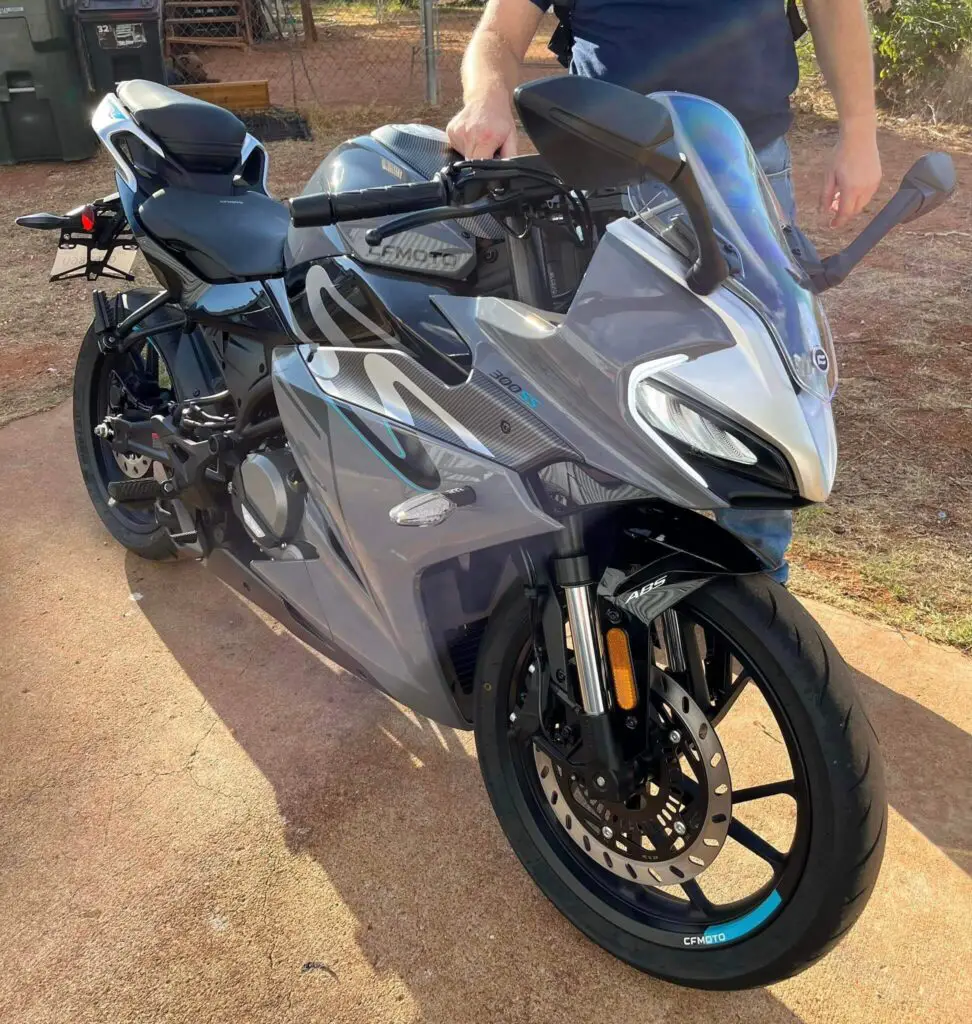
The primary factors that influence the 300SS’s maximum velocity are:
- Engine power output – At 29 hp, there’s simply not enough grunt for blazing high speeds. But reasonable power keeps momentum building smoothly into triple digits.
- Aerodynamics – The 300SS features a full-fairing design providing decent wind protection. Compact dimensions help limit drag compared to bigger bikes.
- Gear ratios – Closely stacked 6-speed gearbox allows the rev-happy engine to keep spinning in its powerband.
- Weight – At 165 kg (364 lb) wet the 300SS strikes a nice balance between stability and ease of direction changes. Light weight also allows quicker acceleration.
- Tires – The 17-inch wheels come fitted with grippy 110 and 140-series radial rubber, allowing the chassis and suspension to handle high speeds more confidently.
While it doesn’t boast hypersport power or top shelf components, the 300SS’s capable chassis, suspension and brakes give it solid high speed credentials considering its class and price point. It ultimately delivers an exciting balance of acceleration, agility and velocity for winding backroad blasts.
How Does The 300SS’s Top Speed Compare to Key Rivals?
The 300SS is a lightweight sportbike that competes with the Yamaha YZF-R3, the KTM RC 390, and the Kawasaki Ninja 400 in the same segment. Here is how its top speed compares to these key rivals:
Yamaha YZF-R3
The Yamaha YZF-R3 is powered by a 321cc liquid-cooled, inline 2-cylinder engine that produces around 42 hp. It has a tested top speed of 112.4 mph in unmodified form. The R3 has more power than the 300SS, but it also weighs more at 375 lbs (wet).
KTM RC 390
The KTM RC 390 is equipped with a 373cc single cylinder engine that delivers 44 hp. It has a top speed of 104 mph, slightly faster than the R3. The RC 390 is lighter than the R3 at 364 lbs (wet), but it has a more aggressive riding position that may not be comfortable for long rides.
Kawasaki Ninja 400
The Kawasaki Ninja 400 has one of the segment’s most powerful engines at 45 hp. It is propelled by a 399cc parallel twin engine that can reach a top speed of 116 mph. The Ninja 400 has more mid-range torque and higher top end power than the 300SS, but it also has a lower redline at 12,000 rpm. The Ninja 400 weighs 366 lbs (wet).
300SS
The 300SS is a new entry in the lightweight sportbike category. It has a 292cc single cylinder engine that generates 21.4 kW (29 hp) @ 8,750 rpm. It has a top speed of around 87 mph, depending on the conditions and the rider. The 300SS is lighter than its rivals at 165 kg (364 lbs) wet, and it has a redline at 8750 rpm. The 300SS offers a balance of performance and handling, with a smooth and responsive engine that rewards riders who can keep the revs high.
What Are the Best Modifications to Make the 2023 CFMoto 300SS Faster?
While the stock 300SS delivers smile inducing performance, here are some of our top modification ideas to unleash its full potential:
- Exhaust system – Install a premium full system exhaust for improved throttle response and higher peak power. Expect 2-3 hp gains.
- Air filter – High flow air filter reduces intake resistance for optimized power delivery.
- Fuel controller – Plug in a fuel controller to fine tune fuelling across the rev range. Makes throttle response crisper while providing extra mid-range punch.
- Sprockets – Adjust gear ratios by going up 1-2 teeth on the rear sprocket. Improves acceleration out of corners by effectively lowering final drive ratio.
- Suspension tuning – Dial in suspension by adjusting preload/rebound for reduced weight transfer and improved stability at high speed. Also allows taking corners faster.
While all delivering minor individual gains, combining selected engine, intake and drivetrain mods can liberate up to 5+ horsepower. Tuning suspension also gives greater confidence during aggressive riding. This helps make the most of the responsive chassis and feisty engine.
Riding Impressions – Handling, Braking and Comfort
Let’s shift focus to how the 300SS performs in real world riding. With sportbike ergonomics and 17-inch wheels shod in grippy 110 and 140-series radials, it’s tailored for aggressive canyon strafing. The steel trellis frame and dialed geometry figures create nimble, instantaneous direction changes. The upside down 37mm telescopic forks and center-aligned, preload adjustable rear mono suspension smooth out rough tarmac effectively for the class.
Hard braking is handled by the capable 4-piston front caliper. It delivers strong, progressive power to rein in speed quickly before corners. The 292mm rotor and Continental ABS means you can brake with confidence, even in slippery conditions. The rear binds up slightly under extreme stopping but overall power felt strong for a singe disc setup.
The narrow midsection and reach to the clip-ons means taller riders may find the fit tight. But the seating position remains comfortable enough for long days in the saddle, with reasonable wind protection. Vibration from the free-revving single cylinder does mean hands can numb slightly after extended durations.
Altogether it achieves a ride dynamic feeling remarkably refined given CFMoto’s newcomer status in the segment. There’s an agility reminiscent of the featherweight Honda CBR250R, combined with stability and feedback approaching the class leaders. Overall it achieves a versatile balance suitable for everything from inner city commuting to attacking your favorite twisty roads.
Key Features and Electronics
In terms of features and electronics, the 300SS arrives suitably equipped considering its entry-level friendly price point. The full color 5-inch TFT display ties into the CFMoto Ride App via Bluetooth, allowing phone connectivity for calls, messages and music. There are also 3 selectable riding modes that adjust throttle map and traction control parameters to suit different conditions.
While not as advanced as pricier machinery, having selectable modes and smartphone integration helps modernize the ownership experience, allowing ease of personalization. Generous LED headlights, taillights and turn signals ensure good vision at night, while ample mirrors keep rearward vision uncompromised. There’s also underseat storage for securing smaller items.
Altogether the 300SS’s features and electronic aids strike a nice balance. Packed with niceties to enhance functionality and convenience without driving up cost or complexity unnecessarily.
How Much Does the 2023 CFMoto 300SS Cost?
In the USA
The 2023 CFMoto 300SS is priced at an MSRP of $4,499. That positions it impressively against rivals – equaling the Yamaha R3 while undercutting both the KTM RC 390 ($5,349) and Kawasaki Ninja 400 ($5,299).
It means buyers get an agile, great sounding 300cc sportbike with modern features for several hundred less than key competitors. Considering the competent chassis, engine and electronics – combined with CFMoto’s 2-year factory warranty, it stacks up as a relative bargain in the lightweight sportbike ranks.
In Canada
In Canada pricing is set at $5,299 CAD, again sharper value versus the Ninja 400, RC390 and R3. There are finance offers available for qualified buyers too, making the 300SS an accessible starting point on the motorcycle ownership journey.
positive and negative owner impressions about the 2023 CFMoto 300SS
Positive Owner Comments
“The 300SS has power that reminds me of my old Ninja 250 but with way better top end. This thing absolutely loves to rev and handles like it’s on rails!”
“I’m new to riding and feel totally confident on the easy to manage 300SS. The riding aids like ABS and traction control give me that extra piece of mind while learning.”
“CFMoto really dialed in the ergonomics for all day comfort. Did a 4 hour ride with no numbness or pain at all. Also loved the Bluetooth integration with my phone.”
Negative Owner Comments
“I wish the 300SS had more power down low rather than needing to constantly downshift. The peaky powerband isn’t ideal for riding in the city.”
“The seat on the 2023 model got harder and more uncomfortable compared to previous years in my opinion.”
“While wind protection is decent, I still experienced some buffeting that caused neck fatigue on longer highway stints above 75 mph.”
“The clutch and gearbox aren’t as buttery smooth as Japanese rivals. Shifting feels a little more mechanical and clunky.”
300SS Pros and Cons Summary
Pros
- Agile, nimble handling
- Strong peak power from revvy motor
- Surprising refinement for class
- Generous electronics and features
- Excellent value for money
Cons
- Peaky powerband demands working the gears
- Cramped for larger riders
- Basic suspension limits aggressive riding
- Styling plays it safe
- Single cylinder vibration at high RPM
Conclusion – Who is the 2023 CFMoto 300SS For?
Whether you’re a first time motorcyclist or seasoned vet looking to downsize, the nimble and affordable 2023 300SS warrants consideration. Its 292cc single has ample zap for slicing up backroads or urban duties, with rideability similar to a 250 but more muscle for highway use.
The chassis and suspension deliver agile handling – perfect for carving roads or slicing through traffic. There’s respectable stopping power too for a single 292mm front disc setup, enhanced by Continental ABS. While power focuses in the upper revs, there’s usable thrust from low RPM to keep you moving briskly.
Ergonomics won’t agree with very tall riders but remain friendly to average folks for all-day rides. Extras like riding modes, Bluetooth connectivity and LED lighting add value that belies its tempting price. While the 2023 Yamaha R3 offers more peak power and Honda’s CBR300R greater around town scoot, neither match the CFMoto’s poise and versatility.
New riders will find its smooth power, neutral handling and 364 lb wet lightweight mass perfect for developing skills. More advanced pilots will appreciate its nimble chassis and revvy intake howl too. Ultimately, the polished yet penny-pinching 300SS deserves shortlisting by anyone seeking an exciting, contemporary lightweight sportbike.
